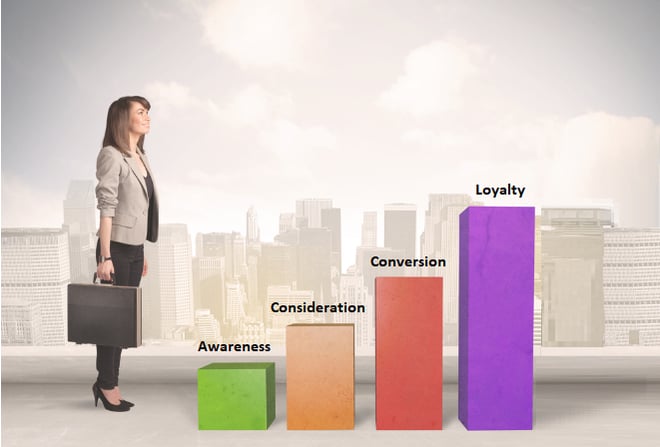
In the digital age, search engine optimization is a crucial aspect of driving organic traffic and conversions for businesses. Likewise, understanding each stage of your customer’s journey is essential for attracting quality leads and converting them into sales.
Combining targeted messaging according to progress at each stage of the sales funnel is what we refer to as “Customer Journey SEO”, which is in essence how the customer journey and SEO influence one another at each stage of the buying process.
 Photo courtesy of iStock Photo
Photo courtesy of iStock Photo
Awareness Stage
The first stage of the customer journey is the awareness stage, where potential customers become aware of their needs or challenges. To cater to this stage, businesses must define their target audience and understand their search intent. Conducting thorough keyword research and analysis helps identify relevant search queries and ensures that your content aligns with what potential customers are looking for. Creating informative and engaging content, such as blog posts, articles, and infographics, helps attract prospects seeking valuable information.
Consideration Stage
At the consideration stage, potential customers are evaluating their options and comparing different solutions. To optimize for this stage, focus on optimizing landing pages with relevant keywords and compelling meta descriptions. Implement internal linking strategies to guide users to related content, enabling them to explore different options. Leveraging user-generated content and reviews builds trust and credibility, influencing their decision-making process positively.
Conversion Stage
The conversion stage is where potential customers are ready to make a purchase or take the desired action. To encourage conversions, ensure your website is user-friendly, fast-loading, and easy to navigate. Implement clear and persuasive calls-to-action (CTAs) on conversion-focused pages, guiding users toward their desired action. Using structured data markup enhances your search engine visibility and increases the likelihood of rich snippets, attracting attention and driving clicks.
Loyalty Stage
The loyalty stage focuses on retaining customers and turning them into brand advocates. Implement post-purchase engagement strategies, such as personalized emails, to nurture the relationship with existing customers. Encourage customers to leave reviews and testimonials, improving social proof and contributing to SEO rankings.
Continuously monitor and improve user experience to ensure customer satisfaction, encouraging repeat business and positive word-of-mouth referrals. Additionally, regularly evaluate and adapt your SEO efforts to respond to changing trends and user behavior, ensuring sustained improvement in SEO rankings.
Creating an Effective SEO Customer Journey
Setting Goals, KPIs, and Keyword Research
Define measurable objectives for your SEO strategy, such as increasing organic traffic or improving conversion rates. Identify key performance indicators (KPIs) to track progress and measure success over time.
Conducting Competitive Analysis
Analyze your competitors' SEO strategies to identify gaps and opportunities. Evaluate their keyword targeting and backlink profiles to benchmark your own performance and develop a more robust SEO strategy.
Conducting Keyword Research
Keyword research involves identifying the most relevant and high-traffic keywords related to your business, product, or service. By understanding what your target audience is searching for, you can create content that resonates with them and improves your search engine rankings. It's a game changer for your successful SEO strategy.
To conduct effective keyword research, leverage tools like Google Keyword Planner, Ahrefs, or SEMrush. These platforms provide valuable insights into search volume, competition, and suggested bid prices for keywords. Additionally, consider incorporating long-tail keywords—specific phrases that may have lower search volumes but are less competitive and highly targeted.
When conducting keyword research, focus on the following factors:
- Search Intent: Determine the user’s intent behind their search query. Are they seeking information, a product, or a service?
- Relevance: Ensure the keyword is highly relevant to your business, product, or service.
- Competition: Assess how competitive the keyword is. Are there many websites already ranking for it?
- Search volume: Evaluate how many people are searching for the keyword.
By carefully considering these factors, you can develop a robust keyword strategy that drives targeted traffic and boosts your search engine rankings.
On-Page Optimization
Conduct technical SEO audits to ensure proper indexing and crawlability. Optimize website structure, URLs, and meta tags for relevant keywords to improve search engine rankings. Prioritize website speed and mobile responsiveness to enhance user experience, which is a crucial ranking factor.
Content Strategy for Target Audience
Develop a content plan that aligns with the customer journey stages. Create high-quality, relevant, and optimized content targeting your chosen keywords. Incorporate various content formats, including text, images, and videos, to cater to diverse user preferences.
Content Design and User Experience
Your website’s content and design should not only be optimized for search engines but also provide a seamless and enjoyable user experience. By creating informative and engaging content, you can enhance your search engine rankings and drive more traffic and conversions.
To optimize your content design and user experience, consider the following strategies:
- Clear and concise headings and subheadings: Use headings and subheadings to break up content and make it easier to read.
- Bullet points and short paragraphs: Present information in bullet points and short paragraphs to improve readability.
- Visual elements: Incorporate images and videos to break up text and add visual interest.
- Internal linking: Use internal linking to guide users to related content, enhancing their journey through your site.
- Responsive design: Ensure your website is accessible and user-friendly on all devices, from desktops to mobile phones.
By focusing on content design and user experience, you can create a website that not only ranks well in search engine results but also engages and converts visitors effectively.
Link Building and Off-Page SEO
Earn high-quality backlinks from authoritative and relevant websites to boost your domain authority and search rankings. Build relationships with influencers and industry experts to collaborate on content and gain exposure. Implement local SEO strategies to increase visibility for location-based searches, especially for businesses with physical locations.
Monitoring, Analysis, and Optimization for Search Engine Rankings
Track your SEO efforts using tools like Google Analytics and Google Search Console. Analyze user behavior and conversion data to identify optimization opportunities. Make data-driven adjustments to your SEO strategy based on performance insights, continuously improving your website’s visibility and engagement.
Implementing a Successful SEO Customer Journey
One real-life example of a B2B company that successfully implemented an SEO strategy based on the customer journey is HubSpot. This is actually quite intriguing as HubSpot not only provides solutions for the implementation of an SEO Customer Journey Strategy for its customers but also “puts their money where their mouth is” so to speak by using it for their own marketing efforts as well.
HubSpot's SEO strategy revolves around understanding and catering to its customer's needs at each stage of their buying journey. They create content that aligns with different stages of the customer journey, such as blog posts for awareness, in-depth guides for consideration, and case studies for the decision-making stage. They optimize this content with relevant B2B-focused SEO keywords to ensure it ranks well in search engine results.
For instance, suppose a potential customer is in the awareness stage, searching for information on "B2B lead generation best practices." HubSpot's blog posts addressing this topic will likely appear in the search results, attracting the prospect to their website. Once on the website, HubSpot continues to engage the prospect with valuable content and relevant calls-to-action (CTAs) that guide them further into the customer journey funnel.
As the prospect moves through the consideration stage, they might search for more specific solutions like "B2B lead generation tools comparison." HubSpot provides comprehensive guides and comparison content to address these queries, positioning itself as an authority in the industry.
Finally, when the prospect reaches the decision-making stage, they might search for the "best B2B marketing automation software." HubSpot's case studies and customer success stories help reassure the prospect and encourage them to make a well-informed decision.
By aligning its SEO strategy with the customer journey, HubSpot successfully attracts and engages potential customers, guiding them through the sales funnel and ultimately converting them into satisfied clients. This customer-centric approach to SEO has been a crucial factor in HubSpot's growth and success as a leading B2B marketing software company.
Summary
A well-structured SEO customer journey is essential for driving organic traffic and conversions effectively. By aligning your SEO strategy with the needs and preferences of your target audience at each stage of their decision-making process, you can optimize their experience and increase the likelihood of conversions.
Remember, SEO is an ongoing process that requires continuous monitoring and optimization based on data-driven insights. If you need a trusted partner to help implement a comprehensive SEO strategy that addresses every stage of your customer's journey, then contact KeyScouts today for a free assessment of the best way to achieve your digital marketing goals.




